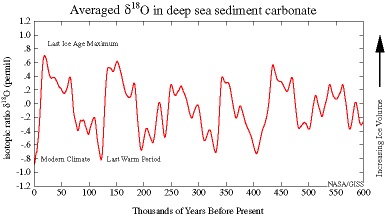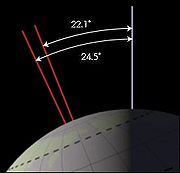
100,000-year problem
Encyclopedia

Geologic temperature record
The Geologic temperature record are changes in Earth's environment as determined from geologic evidence on multi-million to billion year time scales...
s and the amount of incoming solar radiation, or insolation
Insolation
Insolation is a measure of solar radiation energy received on a given surface area in a given time. It is commonly expressed as average irradiance in watts per square meter or kilowatt-hours per square meter per day...
. The former rises and falls according to the strength of radiation from the sun, the distance from the earth to the sun, and the tilt of the Earth's poles. However, the ice-age cycle, which grows and shrinks periodically on a 100,000-year (100 ka) timescale, does not correlate well with any of these factors.
Due to variations in the Earth's orbit, the amount of insolation varies with periods of around 21,000, 40,000, 100,000, and 400,000 years. Variations in the amount of solar heating drive changes in the climate
Climate
Climate encompasses the statistics of temperature, humidity, atmospheric pressure, wind, rainfall, atmospheric particle count and other meteorological elemental measurements in a given region over long periods...
of the Earth, and are recognised as a key factor in the timing of initiation and termination of ice age
Ice age
An ice age or, more precisely, glacial age, is a generic geological period of long-term reduction in the temperature of the Earth's surface and atmosphere, resulting in the presence or expansion of continental ice sheets, polar ice sheets and alpine glaciers...
s. Spectral analysis shows that the most powerful climate response is at 100,000-year period, but the orbital forcing
Orbital forcing
Orbital forcing is the effect on climate of slow changes in the tilt of the Earth's axis and shape of the orbit . These orbital changes change the total amount of sunlight reaching the Earth by up to 25% at mid-latitudes...
at this period is small.
Reconstructing past climate

Geologic temperature record
The Geologic temperature record are changes in Earth's environment as determined from geologic evidence on multi-million to billion year time scales...
—can be readily inferred from sedimentary evidence, although not with the accuracy that instruments can measure current temperatures. Perhaps the most useful indicator of past climate is the fractionation
Fractionation
See also: Fractionated spacecraftFractionation is a separation process in which a certain quantity of a mixture is divided up in a number of smaller quantities in which the composition changes according to a gradient. Fractions are collected based on differences in a specific property of the...
of oxygen isotopes, denoted . This fractionation is controlled mainly by the amount of water locked up in ice and the absolute temperature of the planet, and has allowed a timescale of marine isotope stage
Marine isotope stage
Marine isotope stages , marine oxygen-isotope stages, or oxygen isotope stages , are alternating warm and cool periods in the Earth's paleoclimate, deduced from oxygen isotope data reflecting changes in temperature derived from data from deep sea core samples...
s to be constructed.
Comparing the records
The record of air (in the Vostok ice core) and marine sediments has been compared with estimates of solar insolation, which should affect both temperature and ice volume. Nicholas ShackletonNicholas Shackleton
Sir Nicholas John Shackleton FRS was a British geologist and climatologist who specialised in the Quaternary Period...
orbitally tuned the Antarctic ice core air (i.e. he matched the signal to this assumed forcing), and used spectral analysis to identify and subtract the component of the record that in this interpretation could be attributed to a linear (directly proportional) response to the orbital forcing. The residual signal (the remainder), when compared with the residual from a similarly retuned marine core isotope record, allowed him to estimate the proportion of the signal that was attributable to ice volume, with the rest (having attempted to allow for the Dole effect
Dole effect
The Dole effect describes an inequality in the ratio of the heavy isotope 18O to the lighter 16O, measured in the atmosphere and seawater. This ratio is usually denoted δ18O....
) being attributed to temperature changes in the deep water.
The 100,000-year component of ice volume variation was found to match sea level records based on coral age determinations, and to lag orbital eccentricity by several thousand years, as would be expected if orbital eccentricity were the pacing mechanism. Strong non-linear "jumps" in the record appear at deglaciations, although the 100,000-year periodicity was not the strongest periodicity in this "pure" ice volume record. The separate deep sea temperature record was found to vary directly in phase with orbital eccentricity, as did Antarctic temperature and CO2; so eccentricity appears to exert a geologically immediate effect on air temperatures, deep sea temperatures, and atmospheric carbon dioxide concentrations. Shackleton concluded: "The effect of orbital eccentricity probably enters the paleoclimatic record through an influence on the concentration of atmospheric CO2". The mechanism causing these cyclic temperature changes remains at the heart of the 100,000-year problem.
Solutions to the problem

The mechanism may be internal to the Earth system. The Earth's climate system may have a natural resonance frequency
Resonance
In physics, resonance is the tendency of a system to oscillate at a greater amplitude at some frequencies than at others. These are known as the system's resonant frequencies...
of 100ka; that is to say, feedback processes within the climate automatically produce a 100ka effect, much as a bell naturally rings at a certain pitch. Opponents to this claim point out that the resonance would have to have developed 1 million years ago, as a 100ka periodicity was weak to non-existent for the preceding 2 million years. This is not infeasible—continental drift
Continental drift
Continental drift is the movement of the Earth's continents relative to each other. The hypothesis that continents 'drift' was first put forward by Abraham Ortelius in 1596 and was fully developed by Alfred Wegener in 1912...
and sea floor spreading rate change have been postulated as possible causes of such a change. Free oscillations of components of the Earth system have been considered as a cause, but too few Earth systems have a thermal inertia on a thousand-year timescale for any long-term changes to accumulate.

Helium-3
Helium-3 is a light, non-radioactive isotope of helium with two protons and one neutron. It is rare on Earth, and is sought for use in nuclear fusion research...
, produced by solar ray
Cosmic ray
Cosmic rays are energetic charged subatomic particles, originating from outer space. They may produce secondary particles that penetrate the Earth's atmosphere and surface. The term ray is historical as cosmic rays were thought to be electromagnetic radiation...
s splitting gases in the upper atmosphere, would be expected to decrease—and initial investigations did indeed find such a drop in 3He abundance. However, there is still the possibility that the 100ka eccentricity cycle acts as a "pacemaker" to the system, amplifying the effect of precession and obliquity cycles at key moments, pushing a system usually in an accumulatory state "over the brink" into a swift melting phase, by providing the lightest of taps. A similar suggestion holds the 21,636-year precession cycles solely responsible. Ice ages are characterized by the slow buildup of ice volume, followed by relatively swift melting phases. It is possible that ice built up over several precession cycles, only melting after four or five such cycles.
A mechanism that may account for periodic fluctuations in solar luminosity has also been proposed as an explanation. Diffusion waves occurring within the sun can be modeled in such a way that they explain the observed climatic shifts on earth. However, the He3 signal again appears to contradict this finding.

Dole effect
The Dole effect describes an inequality in the ratio of the heavy isotope 18O to the lighter 16O, measured in the atmosphere and seawater. This ratio is usually denoted δ18O....
describes trends in arising from trends in the relative importance of land-dwelling and oceanic photosynthesizers
Photosynthesis
Photosynthesis is a chemical process that converts carbon dioxide into organic compounds, especially sugars, using the energy from sunlight. Photosynthesis occurs in plants, algae, and many species of bacteria, but not in archaea. Photosynthetic organisms are called photoautotrophs, since they can...
. Such a variation is a plausible perpetrator of the phenomenon, but only really passes the buck: what changed the importances of land- and sea-based photosynthesis?
The recovery of higher-resolution
Optical resolution
Optical resolution describes the ability of an imaging system to resolve detail in the object that is being imaged.An imaging system may have many individual components including a lens and recording and display components...
ice core
Ice core
An ice core is a core sample that is typically removed from an ice sheet, most commonly from the polar ice caps of Antarctica, Greenland or from high mountain glaciers elsewhere. As the ice forms from the incremental build up of annual layers of snow, lower layers are older than upper, and an ice...
s spanning more of the past 1,000,000 years by the ongoing EPICA project may help to shed more light on the matter. A new, high-precision dating method developed by the team allows better correlation
Correlation
In statistics, dependence refers to any statistical relationship between two random variables or two sets of data. Correlation refers to any of a broad class of statistical relationships involving dependence....
of the various factors involved and puts the ice core chronologies on a stronger temporal footing, endorsing the traditional Milankovitch hypothesis, that climate variations are controlled by insolation in the northern hemisphere. The new chronology is inconsistent with the "inclination" theory of the 100,000-year cycle. The establishment of leads and lags against different orbital forcing components with this method—which uses the direct insolation control over nitrogen-oxygen ratios in ice core bubbles—is in principle a great improvement in the temporal resolution of these records and another significant validation of the Milankovitch hypothesis.

